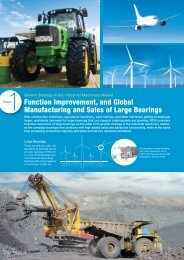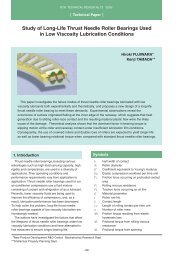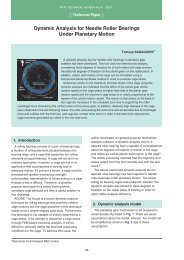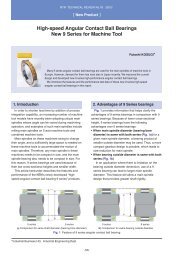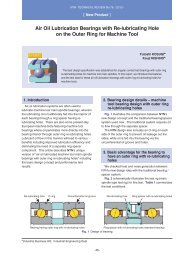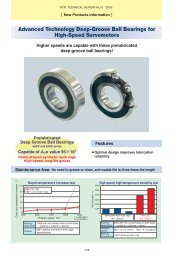Special Issue; Products for Industrial Machinery - NTN
Special Issue; Products for Industrial Machinery - NTN
Special Issue; Products for Industrial Machinery - NTN
Create successful ePaper yourself
Turn your PDF publications into a flip-book with our unique Google optimized e-Paper software.
<strong>NTN</strong> TECHNICAL REVIEW No.742006<br />
Technical Paper <br />
The Influence of Hydrogen on Tension-Compression and<br />
Rolling Contact Fatigue Properties of Bearing Steel<br />
Hiroshi HAMADA<br />
Yukio MATSUBARA<br />
In this report, the fatigue properties of JIS-SUJ2 bearing steel<br />
were investigated under various hydrogen pre-charging conditions.<br />
The results demonstrated that the fatigue strength substantially<br />
decreased by the influence of hydrogen and that the decrease of<br />
the fatigue strength was in direct correlation with the diffusible<br />
hydrogen content. Additionally, double-roller rolling-sliding contact<br />
fatigue tests were conducted to investigate the influence of<br />
hydrogen on surface crack initiation life and microstructural change beneath contact surfaces. As a<br />
result, surface cracking occurred much earlier as compared to the calculated life. The crack initiation<br />
life decreased as the amount of the diffusible hydrogen increased. Unusual microstructural changes<br />
were distinctly observed when a relatively high concentration of the diffusible hydrogen had<br />
penetrated. In contrast, a relatively low amount of diffusible hydrogen did not always cause unusual<br />
microstructural changes, although only marginal difference was seen in the surface crack initiation<br />
life <strong>for</strong> varying levels of diffusible hydrogen content above 0 ppm.<br />
1. Introduction<br />
In certain bearing applications with automotive<br />
auxiliary equipment, it has been known that premature<br />
flaking accompanied by unusual microstructural<br />
changes can occur under rolling surfaces, and that<br />
one typical cause of this problem appears to be<br />
hydrogen embrittlement. 1) In addition, though a very<br />
rare occurrence, premature flaking sometimes occurs<br />
in actual applications, and the cause is difficult to<br />
determine. Currently, many researchers believe that<br />
hydrogen-induced failures accompany microstructural<br />
changes. However, assuming that microstructural<br />
changes result only from the penetration of a large<br />
amount of hydrogen, then there is the possibility that<br />
hydrogen can induce premature flaking without<br />
accompanying microstructural change.<br />
The effects of hydrogen on the fatigue<br />
characteristics of bearing steel were evaloated using<br />
an ultrasonic fatigue test. High-speed load application<br />
during this test inhibits dissipation of hydrogen. This<br />
paper reports the results of this test.<br />
In addition, this paper also reports the results of the<br />
investigations into the effects of hydrogen on surface<br />
crack initiation life and microstructural change<br />
behavior using the double-roller rolling-sliding test.<br />
2. Test Methods<br />
2.1 Material<br />
The chemical composition of JIS-SUJ2 bearing<br />
steel, which was the material analyzed, is summarized<br />
in Table 1. The material was subjected to a standard<br />
quenching/tempering process under the heat<br />
treatment conditions summarized in Table 2, and was<br />
finished to the specified test piece dimensions through<br />
a grinding process. The surface hardness after heat<br />
treatment was HV747 and the residual content,<br />
determined through an X-ray diffraction method, was<br />
9.3%. These values mean that the test pieces feature<br />
standard heat treatment quality.<br />
2.2 Ultrasonic fatigue test method<br />
The ultrasonic fatigue test executed was an axial<br />
load fatigue test (stress ratio: R = –1) in which each<br />
test piece was brought into a resonant state by<br />
Elemental Technological R&D Center<br />
New Product Development Dept. New Product Development R&D Center<br />
-54-



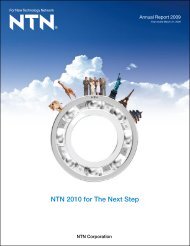
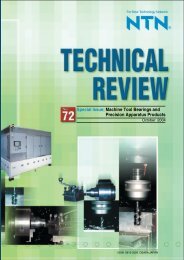
![[New Product] Unit Products for Office Equipment - NTN](https://img.yumpu.com/27154451/1/184x260/new-product-unit-products-for-office-equipment-ntn.jpg?quality=85)
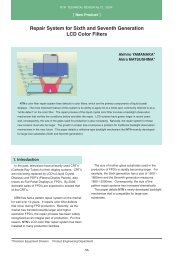
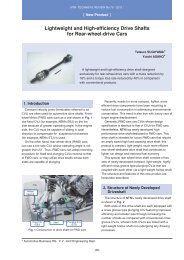
![[New Product] Development of Oil-impregnated Sintered ... - NTN](https://img.yumpu.com/27154427/1/184x260/new-product-development-of-oil-impregnated-sintered-ntn.jpg?quality=85)

